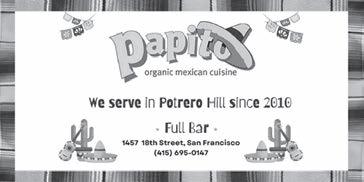Port of San Francisco Grapples with Surging Sea
BY JESSICA ZIMMER
By 2100, sea levels are expected to rise by four to seven feet along the stretch of Bay from Fisherman’s Wharf to Heron’s Head Park. If left unchecked, the rising waves will pollute drinking water with salt and other contaminants, flood buildings, homes, and infrastructure, and inundate roads, parks, and open space.
The Port of San Francisco, which owns the impacted land, is floating seven possible strategies to adapt to the new sea normal. The options, A through G, would also help protect against earthquakes. The Port is surveying the public about the different approaches, which were drafted in partnership with the U.S. Army Corps of Engineers and other municipal agencies, including the Planning Department and San Francisco Municipal Transportation Agency. The Port’s engagement efforts have so far included video conferences, walking tours of Mission Creek and Mission Bay, and community mixers held on the southern waterfront.
“The next step in the process will be evaluating the strategies using a series of metrics and frameworks in collaboration with our City and federal partners as well as the feedback we’ve heard from the community,” said Adam Varat, deputy program manager of planning for the Port of San Francisco’s Waterfront Resilience Program, which is leading the effort. “We will also develop preliminary cost estimates for the different strategies. Our target is spring 2023.”
Roughly two-thirds of the funds needed to implement the ultimately selected strategy will come from the federal government, so long as the Corps’ is engaged in the project. The Corps has a long history of building coastal fortifications to protect cities from flooding. Last fall, the Biden Administration stated that in the future the Corps would principally rely on lower cost naturebased climate adaption approaches. These include using wetlands and native plants to manage stormwater in lieu of engineered management systems; and gardens to collect rainwater before it filters into the ground.
The remaining one-third of the funds needed to implement adaptation
Diesel Backup Generator Population
BY STEVEN J. MOSS
The San Francisco Bay Area continues to host a steadily growing hive of dispersed diesel generators; those low buzzing big boxes located at internet server farms, hospitals, police stations, and, during festivals, Golden Gate Park.
In 2019, roughly 6,500 backup generators, known as “BUGs,” were littered across the region, able to produce a collective 3.8 gigawatts (GW) of power. In 2021 – less than three years later – BUG deployment had reached 8,722 generators, 4.8 GW of power, a 34 percent jump in the backup generator fleet.
By the end of 2022 the Bay Area’s BUG population totaled 9,121, with a collective capacity of more than five GW. Ninety percent of these gensets are diesel powered.
San Francisco is a fertile nesting ground for BUGs. In 2019 there were some 800 in the City. Today there are 1,208, with a combined generating capacity of 736 megawatts, enough to power all of San Francisco’s homes and businesses on a mild spring day.
These numbers exclude the thousands of smaller gasoline, propane, and diesel-powered generators located in backyards and garages. All emit polluting air emissions, much of which may go undetected by air quality regulators.

The engines mostly sit idle, waiting to be called on during an electricity grid
Therapists Help their Clients Cope with Social Anxiety, Job Insecurity
BY REBEKAH MOAN
Therapists in Potrero Hill and Dogpatch are helping their clients cope with a new set of issues after a rocky few years of COVID. In addition to perennial problems of holiday stress, depression, and generalized anxiety, patients are nervous about social situations and worried that they’ll be laid off, given downsizing in the tech industry and what appears to be an emerging regional economic recession.

“Re-entering the social flow after being so much more isolated is making people more socially anxious than previously,” said Deborah Whiting, MSW, who has been in practice for more than 40 years, 30 on Arkansas Street.
A characteristic feature of social anxiety is avoiding social gatherings, with worries about communal interac-
tions complicating work, relationships, and quality of life.
Lisa Andresen, LCSW, a therapist for high-achievers and entrepreneurs with offices on Third Street, confirmed that many of her clients are seeking therapy to manage social anxiety.
“During COVID, sheltering-in-place at home wasn’t considered avoidance,” she said. “Now, people are re-emerging and some are finding it harder than others to put themselves back out there. That disconnect between wanting to connect with others and dreading it is starting to come front and center for people to the point that they’re seeking therapy to address it.”
Clients don’t necessarily state, “I’m socially anxious,” but they might describe feeling lonely, having trouble making friends, or that they don’t have a lot going on outside of work, she added.
“As we unpack it, they know all the things they need to do, but they find it hard to take action,” she said. “They say they want to hang out with friends but wonder why they spend a week preparing for it and then watch for the exit when they arrive.”
Anne Diedrich, MFT, a licensed therapist since 1995, who relocated her offices to Third Street in 2018, has noticed similar patterns. Diedrich works with children and adults, primarily new parents and those in their 20s and 30s concerned about finding and keeping partners and raising families.
“I’m noticing social anxiety cropping up in adults but it’s really apparent in kids,” she said. “I work with elementaryage kids, and teens as well, but with the younger kids, so much growth occurs in
FREE
the Potrero
and SOMA Neighborhoods Since 1970 JANUARY 2023 INSIDE Short Cuts Pg. 2 Why I Raise My Kids in San Francisco Pg. 3 Live-Fire Cooking, Community, at Osito Pg. 4 Potrero-Annex: Steadily Being Rebuilt Pg. 5 Community Calendar Pg. 6 What's In Your Closet? Pg. 9
Serving
Hill, Dogpatch, Mission Bay
Backup
San Francisco
1,208,
84 additional BUGs
at the San Francisco International Airport and
areas adjacent to city boundaries. Five BUGs were not mapped due to incomplete data.
generator population in
grows to
mostly diesel.
are located
other unincorporated
SOURCE: Bay Area Air Quality Management District; M.Cubed, 2022 BUGs continues on page 8
SEA LEVELS continues on page 9 THERAPISTS continues on page 8
SHORT CUTS
Health
San Francisco plans to open its first psychiatric hospital specifically designed to help youth experiencing a mental health crisis at Zuckerberg San Francisco General Hospital. The facility will be funded by a $33.7 million state grant to the San Francisco Department of Public Health and will include a 12bed psychiatric inpatient program and a 24-slot intensive behavioral health outpatient program. Currently, the only psychiatric beds catering to youth in the City are in private hospitals; just 15 beds exist for adolescents experiencing an emotional breakdown, located at St. Mary’s Medical Center. When these are fully occupied, San Francisco youth in a mental health crisis are often referred to hospitals out of the county. The expansion could serve up to 450 youth annually through inpatient services and 900 with outpatient treatments. State funds will be invested this year to renovate two large unused spaces at SF General to bring them up to code for youth medical services. The 12-bed inpatient adolescent psychiatric hospital will operate on General’s seventh floor; the sixth floor will expand current outpatient services. It’s not yet known when the beds will be available.
Dance
ODC has added a third building to its Mishpot network of performance

spaces, classrooms, and studios. The new addition, 3175 to 3177 17th Street, formerly occupied by Seven Tepees, is next door to ODC Theater, around the corner from the multi-purpose ODC Dance Commons, 351 Shotwell Street.
The $6.7 million acquisition will increase the company’s total footprint by 40 percent, from 36,000 to 50,400 square feet. The added space will be used to house ODC activities and be available to other performance groups…Construction of the Mission Bay Elementary School is proceeding, with the contractor collaborating with utility companies to locate existing underground utilities for removal/demolition, a process that’ll continue into early next year.
Free
Last month’s San Francisco Free Museum Weekend, made possible by an anonymous benefactor who paid admission costs at all San Francisco museums, demonstrated that art for free creates a free for all. On the Saturday of the event the Museum of Craft and Design had one of its biggest days ever, with 1,200 people keeping their Alexander Hamiltons in their pockets. On Sunday, the San Francisco Museum of Modern Art drew 9,253 viewers, topping the 2017 paid admission record of 9,070… The San Francisco metropolitan population shrank by 64,934 people between 2016 and 2021, a 1.4 percent decrease, in a period in which
the national populace increased by 2.8 percent. San Francisco is one of just eight large U.S. metropolitans to see its population decline.
Cops
“In a drab building flanked by police vans in Potrero Hill, there’s a windowless room where a handful of officers sit among empty desks and computer screens,” starts a recent story in The San Francisco Standard. “A wall of televisions play the news. Military flags hang from the ceiling. Phone numbers are scrawled on a whiteboard. Without stepping outside, it’s hard to tell if it’s day or night.” The article goes on to convey that the room, located in the municipal building at 17th and De Haro streets, is where problem cops are parked to bypass the difficult process of removing sworn officers. At the Department Operations Center San Francisco police officers field phone calls, email bulletins and run a database of missing and stolen vehicles instead of patrolling the streets. Uniforms aren’t required. For some, they’re not allowed, because the Operations Center is a de facto holding facility for cops deemed unfit to don a badge, gun or police blues. Many of the officers are in limbo because state law makes it hard and time-consuming for the department to enforce its own rules. They can spend years earning a good salary for work that may not require much law enforcement training. Meanwhile, the San Francisco Police Department is short more than 500 officers.
Union
Last month roughly 50 demonstrators, including community members, organizers and a dozen workers rallied in front of Tartine Manufactory to push for a union contract. Despite formally unionizing in March 2021 with the International Longshore and Warehouse Union, Local 6, workers at the bakery, with locations in the Mission and Mishpot, have yet to receive a union contract. At the center of the conflict: increased wages in an era of ever-rising living costs.
Corrections
The December Short Cuts , “ Bus Yard Development Lurches Forward” contained a few errors. The accurate number of planned housing units is 575. Plenary Americas US Holdings Inc, the project lead, is headquartered in Los Angeles and has a history of developing complex infrastructure projects as part of public-private partnerships.
ACCOUNTING MANAGER Catie Magee

 MANAGER Richard Romero
MANAGER Helena Chiu
MANAGER Richard Romero
MANAGER Helena Chiu
2 THE POTRERO VIEW January 2023
PUBLISHER Steven J. Moss
PRODUCTION
THIS MONTH’S CONTRIBUTORS Copyright 2023 by The Potrero View. All rights reserved. Any reproduction without written permission from the publishers is prohibited.
MARKETING
THE VIEW IS PRINTED ON RECYCLED NEWSPRINT WITH SOY-BASED INK. Editorial and policy decisions are made by the staff. Published monthly. Address all correspondence to: THE POTRERO VIEW, 1459 18th Street, Number 214, San Francisco, CA 94107 • 415.643.9578 E-mail: editor@potreroview.net • production@potreroview.net (for advertising)
Mariangela Mistretta, Rebekah Moan, Steven J. Moss, Matt Namy Vivien Wang, Jessica Zimmer
$68 Subscription $132 Subscription-Benefactor Other contribution amount $ Please send my one-year subscription to: FULL NAME EMAIL ADDRESS STREET ADDRESS CITY STATE ZIP CODE Enclosed is my check. Please send, along with this form, to: The Potrero View, 1459 18th St., #214, S.F., CA 94107 I am sending my payment via PayPal to office@potreroview.net. I love the View and would be delighted to support it by being a subscriber. YES! www.potreroview.net/product/subscribe or complete the form below SUBSCRIBE ©2022 Corcoran Icon Properties. All rights reserved. Corcoran® and the Corcoran Logo are registered service marks owned by Corcoran Group LLC. Corcoran Icon Properties fully supports the principles of the Fair Housing Act and the Equal Opportunity Act. Each franchise is independently owned and operated. Data from SFAR MLS, homes sold between 11/20/22–12/20/22 excluding BMR sales. Information deemed reliable, but not guarenteed. REALTOR ® LIC# 01312854 WesFreas@CorcoranGL.com +1 415.518.6538 REALTOR ® LIC# 01854549 WendyWatkins@CorcoranGL.com +1 415.367.5997 WesandWendyHomes.com WENDY WATKINS WES FREAS Happy New Year! Reach out to learn more about today’s market. From first time home buyers to savvy sellers, we're looking forward to surpassing your highest expectations in 2023. Latest Sales Activity on the Hill Address 360 Missouri St 362 Missouri St 479 Texas St #1 883 De Haro St 851 Wisconsin St 501 Kansas St 475 Connecticut St 451 Kansas St #551 712 De Haro St 731 Wisconsin St 562 De Haro St 415 De Haro St #203 Type Tenancy in Common Tenancy in Common Condo Single Family Single Family Single Family Single Family Condo Single Family Single Family Condo Condo Bed / Bath 3 / 1 3 / 1 2 / 2 4 / 2 2 / 1 3 / 1 2 / 2 1 / 1 4 / 3.5 3 / 3 3 / 2.5 2 / 2 Sale Price $875,000 $1,000,000 $1,535,000 $1,132,000 $1,200,000 $1,805,000 $1,865,000 $770,000 $4,260,000 $2,210,000 $2,475,000 $1,283,000 • SUPPORT LOCAL JOURNALISM • Subscribe to the View ! Annual subscription: $60 potreroview.net/product/subscribe/
Why I Raise My Kids in San Francisco
BY MARIANGELA MISTRETTA
It was a foggy October afternoon in 2013 when we arrived in San Francisco. Me, my husband Samuel, daughter Daria, now 11, a stroller, car seat and nine suitcases in a large taxi. We were driving from the airport to the City, the place we were about to call home. A few months earlier in Switzerland, where we were living, we’d made a rather quick decision to move to the Bay Area. New opportunities; a fresh start.
Our chatty driver seemed rather excited about our new adventure and was eager to inform us about what to expect in San Francisco. He started with Karl the fog (the fog has a name?) and the City’s unique microclimates. That dusky afternoon, jetlagged and quite nervous about this new chapter of our life, having left behind family, friends, house, and jobs his voice sounded
Letters to the Editor
Editor,
I’m writing to express my surprise at the View’s experience with Supervisor Walton’s office as related in the “Emails Unanswered” paragraph in the Short Cuts section of the December issue. I, and many other neighbors and community members, have found Supervisor Walton’s office to be extremely responsive to our inquiries, requests for information and support for neighborhood issues. It’s rare to wait even 24 hours for a response.

HANDY NUMBERS
like a remote buzz from the radio. My foggy brain was tuned into a different frequency, “What if I don’t like it here? Do we have a Plan B?”
Nine and a half years have passed. We never needed a Plan B, but rather a plan to manage the City’s volatile weather; the driver was right after all. Never forget to dress in layers! Although our early days were filled with the classic funny or stressful situations that occur when you move to another country/continent, we’ve been blessed with amazing friends, caring neighbors, incredible teachers, and plenty of unexpected sunny days that’ve brightened our way while we were adjusting to our new life. As they say, you need a village.
Potrero Hill is the neighborhood where we decided to settle down. Or rather the neighborhood that chose us. It has the best weather, views, and atmosphere in the City; I know my opinion is biased! Here our family grew as we welcomed our second daughter, Eliana, seven, who today is a proud San Franciscan!
San Francisco made it easy to fall for her. I’d already started romanticizing about the City many years earlier while reading about its social and cultural movements, Kerouac and Ferlinghetti. You can imagine how it felt to find out that Ferlinghetti lived on Wisconsin Street. I was meant to land right here in Potrero.
We’re delighted by the City’s multicultural soul. We, a multicultural family ourselves – Italian, Swiss, and American – have found our tribe here. It’s a comfortable environment where dichotomies naturally coexist and become fertile ground for new ideas. There’s a


reason that San Francisco has always been an incubator for innovation. Here different backgrounds are welcomed, diversity is real, and inclusion isn’t just a word but an ideal that people strive for. Lately even more so. In a world that’s too often polarized and where extremisms easily flourish, we’re happy to raise our daughters in a City where “compassion” isn’t just a word.
We know San Francisco isn’t perfect and has serious issues that we all want to see resolved. Our own neighborhood is no exception. But no place on earth is perfect. The cities in Italy, Spain, Switzerland and France where we lived before moving to the Bay Area have their own struggles.
I hear people have lost faith in San Francisco’s ability to shine. The pandemic has hit the City hard. But this place is resilient. Its people know how to tap into their shared sense of community to provide solutions. Here you can build communities around a school, a neighborhood, a park, even around pets! In the other metropolises where we’ve lived, individualism is more in vogue. We as foreigners – who isn’t a foreigner in San Francisco – have benefitted from San Francisco’s culture of mutual support.
This feeling of belonging is the premise for people to be happy and thrive. This is possibly the true reason why we love the City. It makes us happy to know that our children are immersed in this culture. Every time I’m on my way back from the airport and I start seeing the City’s unique skyline wrapped in Karl’s arms from the freeway, I feel grateful to live here.
3 January 2023 THE POTRERO VIEW
District 10 Supervisor 415.554.7670 Shamann Walton waltonstaff@sfgov.org Recology 415.330.1300 San Francisco Animal Care and Control 415.554.6364 San Francisco Fire Department (non-emergency) 415.558.3200 San Francisco Police Department 671-2300; tip line, 415.822.8147 SFPDBayviewStation@sfgov.org SFHOT/Homeless Outreach Team 311 or 415.734.4233 State Senator Scott Weiner 415.557.1300
Jude Deckenbach Friends of Jackson Park
Michelin-star Osito Celebrates Live-Fire Cooking and Community
Green Benefit District | GreenBenefit.org
Come help plant a new 4,000 sq. ft. native plant garden on Iowa St on Saturday, January 14. And GBD Board elections are coming up in March. Candidate sign up runs January 1-31. Planting volunteers and those interested in running for the board can get more info and sign up on the GBD website at GreenBenefit.org.



Starr King Open Space | StarrKingOpenSpace.org
The Starr King Open Space needs your support. We are holding a holiday fundraising effort, check out StarrKingOpenSpace.org to learn more. Please join our monthly volunteer days on the second Saturday of the month from 9:30 a.m. to 12:30 p.m. This month it is January 14th..
BY VIVIEN WANG
Located on the corner of 18th and Florida streets, Osito is San Francisco’s only 100 percent live fire, fine-dining restaurant. Having just celebrated its one-year anniversary, Chef Seth Stowaway takes culinary inspiration from his childhood in Texas, his neighbors, and local food purveyors and farmers.
Osito,”little bear” in Spanish, references a significant period in Stowaway’s life.
“When I was first getting sober and found my way into the kitchen at Bar Agricole, my favorite porter there, Medardo, called me ‘osito’ because of my big beard. That was the first community I had in my sober life; I was smoking crack in the Tenderloin before that,” he said.
On Osito’s website, a note from the chef shares that “Our entire journey has been a story of community: the team, makers, farmers, investors and friends whose support is the only reason we made it against the odds.”
Osito emerged during the pandemic, a context that prompted Stowaway to create a venue where people could celebrate together.
“I want Osito to be a place where you can get the kind of care and attention to detail that any fine-dining restaurant offers, but where the focus is on togetherness,” he said. “People are meant to be in community, and to celebrate with each other. We just went through a period where no one got to be together, so this feels even more special, post-pandemic.”
As a 15-year veteran of the Bay Area’s fine dining scene, Stowaway had considerable expertise to draw upon to create a new restaurant, choosing live fire as his medium.
“Committing all the way to live fire determined what was our voice going to be and forced a more specific opinion on palates and tools,” he said. “I wanted to put parameters and restraints on our cooking.”
Having built relationships with local farmers and ranchers Stowaway’s menus are built around what’s available—not necessarily what’s in market— and what his purveyors are most excited about. Changing every six weeks, the eclectic, seasonal bill of fare honors the diverse group of people that work at Osito. The team identifies a theme and
brainstorms ideas together on a shared Google doc.
“It’s not just my opinion at the table,” said Stowaway.

A recent menu was “Game Birds 2: Forest and Festivities,” a celebration of coastal California and the holiday season, inspired by Stowaway’s business partner Jen Yu’s Korean background. It includes a consommé made with liquid from kimchi and her favorite banchan.
The space’s cozy 26-seat communal dining table and central kitchen is decked out in reclaimed Douglas fir and feels reminiscent of a Nordic ski lodge. Stowaway wanted the kitchen next to the dining room so that diners could readily interact with his staff.
“I wanted none of the tablecloth, super-proper side of fine dining, but wanted all the steps of service. These are friends that are serving you,” he said.
Asked to name a few words for which he wishes his guests to remember Osito, he said “comfortable, loving, surprising, child-like wonder. I want people to feel loved at the table.”
Stowaway regularly hears about guests becoming friends. Some patrons with gardens bring him their own produce to use.
“We’re good friends with a lot of restaurants around the Mission,” said Stowaway. “We do a lot of community work with several nonprofits, and interns graduating from culinary programs to help youth or people coming from bad situations.”
He’s thrilled to collaborate with other chefs at Osito, including Slow Burn Takeover, featuring chef team Tiffani Ortiz and Andy Doubraval, and a “celebration of friendship” dinner with Brandon Jew, who he worked with at Bar Agricole.

Having earned a coveted Michelin star last year, Osito is seeing wait times increase for its communal dining experience, which comprises approximately 20 courses; there are nine “drop rounds,” some of which have multiple dishes. Prices range from $215 to $250. Seating is available Tuesday through Saturday from 5:30 p.m. to 9 p.m.
For those who prefer a more casual, drop-in experience, sister bar Lilliana offers the same intimate ambience, with creative cocktails and food from Osito’s kitchen, next door.
4 THE POTRERO VIEW January 2023
HAPPY NEW YEAR! We're feeling really good about 2023! Come to the shop and share your resolutions…drink more coffee perhaps? OPEN 7 DAYS A WEEK: 7:00am - 6:00pm For a $200 annual fee your organization can be listed in Getting Involved. Contact production@potreroview.net
Andy Doubrava and Tiffani Ortiz regularly guest chef at Osito with their restaurant Slow Burn, and will be returning with a menu that combines biodynamic farming, food preservation and fine dining from January 5 to 9. PHOTO: Courtesy of Tony Deifell
Potrero Annex-Terrace Being Steadily
BY MATT NAMY
The Potrero Annex-Terrace housing community, located on the Hill’s southeast slope, has long been largely isolated from the economically thriving neighborhood to the north. The complex is dominated by barracks-like residences that were built more than 80 years ago. For the past 15 years it’s been part of the HOPE SF redevelopment effort, a partnership between municipal agencies, private real estate developers, and The San Francisco Foundation.
BRIDGE Housing, which operates 21 properties in the City, is leading the effort. Once completed Annex-Terrace ownership and management will be transferred from the San Francisco Housing Authority (SFHA) to BRIDGE, with SFHA leasing the underlying land to Bridge.
Under HOPE SF Annex-Terrace is being demolished and rebuilt in five phases, scheduled to be fully completed in 2034. The slow approach is intended to limit displacement of existing residents as well as sync the rebuild to the speed of available financing. The first new building, 1101 Connecticut, was completed in 2019. Phase 2, Potrero Block B, was launched last fall.
Annex-Terrace encompasses roughly 600 housing units with nearly 1,300 residents, 43 percent of whom are African American. Consisting of standalone three-story rectangular structures stacked on hillsides, buildings are beset with broken elevators, plagued by cockroaches and rodents, with poorly maintained plumbing.
“I have gone through many of these units and seen open sewage,” said Edward Hatter, Potrero Hill Neighborhood House executive director. “The pest infestation is out-of-this-world. These conditions are horrible.”

In 2007, former District 10 Supervisor Sophie Maxwell, now San Francisco Public Utilities Commission board member, and then Mayor and now Governor, Gavin Newsom, launched a Task Force to determine how to redevelop public housing into mixedincome communities. The Task Force found a $195 million backlog in repairs at SFHA properties, and a $10 million a year shortfall in federal funding for ongoing maintenance.
Historically, SFHA had been the landowner, builder, and property manager for low-income public housing. Over the past few decades, San Francisco has shifted its approach to affordable housing to a hybrid model. Properties are managed by private companies. SFHA maintains ownership and administers Housing Choice Vouchers, a federal lowincome subsidy. SFHA remains closely involved in HOPE SF projects.
“It is extremely important that the residents are seen as the larger body of the constituent group of the City and County of San Francisco,” Dr. Tonia Lediju, SFHA chief executive officer contended. “It is extremely important that the community is not continued to be marginalized in the way that it has in the past through isolation.”
The goal of redevelopment “is to give…residents the ability to have what we all want in our own lives; a stable,


Rebuilt
healthy, happy home,” said Kendra Crawford, SFHA Director of Housing Operations. “What we really want is for residents to get a great job, to be able to buy a house…this housing is not intended for the families to live forever.”
More than one-third of AnnexTerrace residences have lived in the complex for longer than a decade. Some families have stayed there over multiple generations.
In total the four HOPE SF sites – Alice Griffith, Hunters View, AnnexTerrace, and Sunnydale – account for 1,900 public housing units. Each will be replaced one-for-one. Housing density will more than double, with a mix of residences affordable to those earning between 30 and 60 percent of the area median income, as well as market-rate homes. The goal is to create economically dynamic and connected communities.
The market rate housing is intended to attract private investors and bring more accountability to longer-term maintenance. Some advocates believe that too much space is being dedicated to market rate homes, and that higher density will spark social problems.
In the Annex-Terrace development plan market rate buildings are
segregated from affordable units. For instance, Potrero Block B consists of 90 replacement and 30 affordable homes. Block A, which’ll be built on the opposite side of Arkansas Street, is fully market rate.
“Originally, BRIDGE and the City came in and proposed a totally integrated community,” said Hatter “A community where you couldn’t tell who was market rate and who was affordable.”
BRIDGE Housing was selected by the City to redevelop Annex-Terrace in 2007. In addition to serving as developer, BRIDGE intends to be the long-term property manager. Currently, the nonprofit is managing 1101 Connecticut.
“Our mission was all about quantity, quality and affordability…,” said Smitha Seshadri, vice president and lead of development for Northern California at BRIDGE. “Over the years that mission has broadened and we are very much about strengthening communities today, and so this is very much in alignment with [HOPE SF]. In addition [to the 1,600 housing units], there is a goal to add retail along the 24th Street corridor, which is to be developed, in addition 30,000 square feet of community-serving POTRERO-ANNEX continues on page 7
5 January 2023 THE POTRERO VIEW
Now through 3/12 Sunday

Art: “Entwined”
“Entwined,” created by Charles Gadeken, offers an illuminated forest, with two 15 to 20 feet tall trees, 10 ranging from eight to 14 feet, and 40 ‘flower clusters’ of varying sizes. It’s a glowing fantasy land, complete with low-level ambient music. 5 to 10 p.m. Free. Golden Gate Park, Peacock Meadow, 240 John F. Kennedy Drive. For more information: https://bit. ly/3BXLaCX
Now through 3/19 Sunday

Art: Bull.Miletic
Artists Synne Bull and Dragan
Miletic identified the emergence of a new, visual paradigm for which they invented the descriptive words: proxistance (noun) and proxistant (adjective). Most prominently exemplified by Google Earth’s “digital ride” from a global perspective to street level view, a proxistant vision names this combination of proximity and distance in a single, moving capture. This unique presentation features three robotic video installations; each artwork has its
own focus; all trace the multiple paths and genealogies of the “proxistant” (overview to detail) effect. 10 a.m. to 5 p.m. Tickets $8 to $10. Museum of Craft and Design, 2569 Third Street. For more information: https://bit.ly/3YKpGU3
1/4 Wednesday
History: GLBT Historical Society Museum
GLBT Historical Society Museum is the first of its kind in the United States. The institution celebrates 100 years of San Francisco’s vast queer past through dynamic exhibitions and programming.
11 a.m. to 5 p.m. Free; sponsored by the Bob Ross Foundation. GLBT Historical Society Museum, 4127 18th Street. For more information: https://bit. ly/3jqOaS4
1/6 Friday
Culture: Contemporary Jewish Museum
Embracing a range of artistic disciplines and media, the museum features contemporary art, historical objects, film, music, conversations, lectures, literary readings, and other live performances that explore
contemporary perspectives on Jewish culture, history, art, and ideas. The institution’s architecture is a work of art. Contemporary Jewish Museum, 736 Mission Street. For more information: https://bit. ly/3BWApAL
1/8 Sunday Environment: Dogpatch Beautification Day
Join Refuse Refuse San Francisco, Shine
On, San Francisco Public Works, and TogetherSF for a friendly neighborhood cleanup. Stay afterwards for a free lunch sponsored by the University of California, San Francisco. 12 to 1:30 p.m. Meet at Woods Yard Park, 22nd and Minnesota streets. For more information and to reserve your spot: https://bit.ly/3WkHYt8
Virtual 1/10 Tuesday
History: “Sutro’s Glass Palace”

Once the world’s largest indoor bathhouse, Sutro’s contained seven swimming pools, art collections, promenades, and museum exhibits, covered by nearly three acres of glass. 20,000 people at once could swim or just observe. Today, only its broken concrete ruins remain at Lands’ End. But even as ruins, Sutro Baths draws thousands of people daily who explore its mysterious foundations and rocky tunnels. This talk covers the story of the legendary structure, and the social milieu in which it existed in the 1890s, including public recreation, class distinctions, and racial segregation. 1:30 to 4 p.m. $35. For more information and to register: https://bit. ly/3jp2IBq
1/12 Thursday through 1/21 Saturday
Theater: Skylight
After a three-year hiatus, Bread & Butter Theatre returns to Potrero Stage
with David Hare’s Tony and Olivier award-winning play Skylight. Broadway and the West End applauded this intensely clear-sighted drama about a love affair. Kyra is surprised to see the son of her former lover in the doorway of her chilly London flat. He hopes she’ll reconcile with his distraught, now widowed, father. Is the gap between them unbridgeable, or can they resurrect their relationship? Tickets: $11 to $21. Potrero Stage, 1695 18th Street. For more information and to purchase tickets: http://bit.ly/3HZ9EQ2
1/14 Saturday
Culture: Museum of the African Diaspora Museum of the African Diaspora celebrates Black cultures, ignites challenging conversations, and inspires learning through the global lens of the African Diaspora. Visit every second Saturday for THRIVE @ MoAD Community Day with free admission to all exhibitions. 11 a.m. to 6 p.m. Museum of the African Diaspora, 685 Mission Street. For more information: https:// bit.ly/3FGNlMk
1/19 Thursday
Art: Asian Art Museum
The Asian Art Museum is open until 8 p.m. on Thursdays with half-price general admission, including special exhibitions. Enjoy the galleries, fun talks, and lively gatherings. 5 to 8 p.m. $10 adults, $8.50 seniors, $7 for students and youths. Asian Art Museum, 200 Larkin Street. For more information: https://bit.ly/3jt9aaU
1/27 Friday – 2/12 Sunday
Theater: Playground Solo Performance Festival
A curation of the best in Bay Area solo performance presented live at San Francisco’s Potrero Stage and simulcast online. The festival of new work features nine double-bill performances by ten California artists over three weeks. Recitals were competitively selected from open applications, reflecting PlayGround’s mission to discover bold new voices and develop innovative and timely original content. Tickets are free with donations gratefully accepted to help support the artists. Potrero Stage, 1695 18th Street. For more information and to purchase tickets: https://bit.ly/3WEewOS

6 THE POTRERO VIEW January 2023 COMMUNITY |JANUARY
Sutro Baths circa 1900.
Photo courtesy of Golden Gate National Recreation Area
POTRERO-ANNEX from page 5 education and recreation spaces, 3.5 acres of new parks and open spaces, and 13.5 acres of reconfigured streets.”
BRIDGE offers scholarships to Annex-Terrace residents ages 16 and up, which can be used for an array of services, including higher education, vocational programs, and language classes.
“The whole Potrero community is near and dear to my heart…,” said District 10 Supervisor Shamann Walton, who spent time in his youth at AnnexTerrace. “Revitalizing, remodeling, and building brand new housing for the existing community is something that has been long overdue and is very important.”
Walton sees the right to return and community participation as keys to a successful project. “The main thing for me is making sure that everybody that lives on site now has the opportunity to stay on site in the new housing… if we have residents working in community, living in community, and not being displaced, that’s a big win for us.”
Walton co-sponsored a 2019 ordinance with Mayor London Breed to clarify the right for public housing residents to return to revitalized HOPE SF sites, provided the household is in good standing with SFHA. The legislation established a third-party board to review relocation plans.

Previous redevelopment efforts have struggled to retain dislocated residents. Under HOPE VI, a federally funded rebuild of public housing between 1993 and 2010, prolonged relocations and an inadequate number of new units caused more than two-thirds of former inhabitants to relocate.
Annex-Terrace redevelopment isn’t federally funded, triggering a lurching need to find monies elsewhere. In 2022, Potrero Block B was only able to progress after the Mayor’s Office of Housing and Community Development (MOHCD) procured $106 million from the California Department of Housing and Community Development for buildings and infrastructure. MOHCD also provided gap loans, with debt financing from JP Morgan Chase.
Annex-Terrace redevelopment is
complicated by the site’s geography. Potrero Block B is being constructed between 25 and 26th streets from north to south and Connecticut and Arkansas streets from east to west. The design includes a basement garage with two buildings rising from the podium level. In addition to housing, there’ll be a childcare facility, interior courtyard, mini park, and 126 parking spots. Construction is scheduled for completion around the end of 2024.
The design is a collaboration between Y.A. Studio and HKIT Architects.
According to Yakuh Askew, Principal at Y.A. Studios, the steeply sloping site in both the longitudinal and transverse directions was the major design challenge. Shallow serpentinite rock compounds the challenges, making cut and fill operations difficult, expensive, and toxic, since serpentinite contains naturally forming asbestos. To accommodate the slopes, the buildings step down with the site.
According to Askew, the design team “worked with the topography so that the experience as you are going down the hill the buildings are reflective of the topography.”
“We try to be efficient in our





planning and clever in our design and strategy to minimize cost,” Rod Hemni, director of design at HKIT. “We are well aware of materials that are durable, that provide the most quality for the least cost.”
Throughout the design process BRIDGE has solicited community feedback about aesthetics, particularly guardrails and outdoor spaces, deploying culturally appropriate artwork. BRIDGE hosts monthly meetings with residents, attended by SFHA and Cahill Contractors.
Hatter, who has engaged in redevelopment discussions over the past 12 years, is frustrated with “takebacks”, noting that washer and dryer hook-

5 @ 11:15am, Church Hall: Free community screening of The Letter, a film by the Laudato Si’ Movement. The film features Pope Francis as the main protagonist among five leaders representing the voices of Indigenous people, the youth, the poor and the wildlife of our planet. You're welcome
Sunday Masses
Vigil 4:15 pm
7 January 2023 THE POTRERO VIEW
“Instead of hookups they had launderettes at the end of the halls in the main floors,” he said.
Come be part of a Welcoming,
CATHOLIC CHURCH Served by the Carmelites
(at
Street)
Rendering of Potrero Block B from Arkansas and 25th streets. PROVIDED BY: Y.A. Studio and HKIT Architects
Warm, Inclusive Faith Community
1490 19th Street
Connecticut
Sunday
Friday
St San Francisco, CA
415.285.5272 w www. StTeresaSF.org St Teresa of Avila’s Church is an EPA ENERGY STAR® certified building.
DATE
St.
’s Feb.
to join us for Mass at 10am and stay for the free screening. March 5: Speaker from The Brady United Against Gun Violence group. More information to follow Melinda Lee Your Agent for Good. e-Pro, SRES | Lic. #01344377 melinda@melindalee.realtor 415.336.0754 | melindalee.realtor 4040 24th Street, San Francisco, CA 94114 ©2022 Corcoran Icon Properties. All rights reserved. Corcoran® and the Corcoran Logo are registered service marks owned by Corcoran Group LLC. Corcoran Icon Properties fully supports the principles of the Fair Housing Act and the Equal Opportunity Act. Each franchise is independently owned and operated. 2023 promises to be an exciting year of change and possibility for real estate. Buyers and sellers are adjusting to market changes, and the Hill continues to be a prime destination neighborhood. You know the old saying, "A goal without a plan is just a wish..." So let's get your plan in order for 2023! CONFUSED ABOUT HOW TO BEGIN? Call me today for a walk-through of your property and a free valuation. Together we'll make a plan to guide you from start to finish. • SUPPORT LOCAL JOURNALISM • Advertise in the View ! For more information: potreroview.net/advertise/
Saturday
8:30 am 10:00 am Weekday Masses Tuesday 8:30 am
8:30 am 390 Missouri
94107
SAVE THE
— Events at
Teresa
outage. But there’s so many of them, a slug of which – known as “prime generators” – are used more actively, that even their intermittent use can add up to notable emissions. In an era in which many California municipalities, including San Francisco, are striving for 100 percent renewable power, the generators are a sticky fly in the ointment.
Although BUGs provide an extra layer of reliability to their owners, a kind of dirty outage insurance, this benefit isn’t considered in multi-billion-dollar generation and transmission investment decisions. Instead, the state’s electricity grid operator, the inelegantly named California Independent System Operator, averts its eyes, and insists on having access to enough other assets to cover multiple potential system failures, excluding BUGs. It’s belt, suspender, button, and snap redundancies that contributes to ever-higher electricity rates.
Last year alone Pacific Gas and Electric Company’s prices jumped by 13 percent.
If they’re triggered, by an earthquake- or storm-induced utility distribution failure, or as part of fire mitigation strategies, the resulting plumes of diesel pollutants are likely to be cold comfort to those left without power. Once they’re run dry, refueling the generators may not be easy amidst a chaotic catastrophe, making them a short-term reliability stopgap.
Distributed generation could provide financial, environmental, and equity benefits if BUGs were replaced with non-fossil-fueled resources, networked into the grid, or deployed as part of community microgrids. California’s fiscal year 2022 budget includes $950 million in incentives to deploy zero or low emission technologies, including fuel cells, at existing or new facilities, and as replacements or to substantially improve the environmental performance of already installed BUGs. The funds are available to support reliability at data centers, hospitals, clinics, water facilities and fire stations. BUG owners that receive state funding have to operate their equipment to support the grid during emergencies.
In addition, the federal Inflation Reduction Act (IRA) extended the renew-
able energy investment tax credit (ITC) for 10 years, increased the base credit from 26 percent to 30 percent and made standalone energy storage ITC eligible. Previously, energy storage only qualified if the batteries were connected to a solar project. The ITC provides a financially viable pathway to deploy storage to replace fossil fueled BUGs. A 10 percent credit bonus can be claimed by facilities located in “energy communities” that have been historically subjected to particularly high pollution burdens, which could include Hunters Point.
THERAPISTS from front page
social situations. Kids lost a lot of ground during the pandemic. They lost time and new experiences with their peers. I see some kids that are really struggling and fearful of their friendships disappearing for no apparent reason; other kids have a block learning to accept that friendships go through ups and downs and that they can try to face their fear that ‘this person might not like me anymore because I did something stupid.’”
Diedrich advises parents to think of their children as socially younger than they are because of the pandemic and associated shelter-in-place and masking orders and to help them identify what they’re worried about.

“They need a little more skill and understanding on how to cope with unexpected social situations in the classroom or with their peers,” she said.
Another population that’s feeling particularly anxious and not overly social is new moms, according to Michelle Cilia, LMFT, a therapist for eight years, practicing for six on 17th Street.
“A lot of what’s come up in the last two years in my work with new moms has been the isolation of the pandemic and being a parent,” she said. “Typically, new moms spend time with one another but people are still freaked out and not doing that because they’re still worried about new babies getting COVID and now RSV is going around. There’s still a ton of isolation for that population and postpartum anxiety and depression have skyrocketed.”
Another topic making the rounds is job stress.
“There’s a lot of disillusionment in tech these days with witnessing poor leadership and layoffs,” Andresen said. “It’s hard for the people who lost their job and it’s hard for the people sticking around. The pressure to prove yourself is even higher. There are hiring freezes with fewer jobs available. People feel stuck, whether they like their job or not.”
According to Cilia, “In this area of San Francisco, the tech layoffs are really anxiety-provoking. The economy was

great, the job market was great, and now it’s not. It’s a big adjustment.”
“I am hearing more from people, ‘If I make it through next week without getting laid off, I think I’m ok,’” Diedrich added.
“In this area, people either work in tech or in some way are in a service position that relates to tech and so the layoffs are really scaring people,” WhitTHERAPISTS continues on next page
8 THE POTRERO VIEW January 2023
BUGs from front page
THERAPISTS from previous page ing said. “There’s a real question of, ‘Can I recover? Can my City recover? Can my industry recover?’ Everyone is looking at the dire edge. They are privately wondering, ‘Is it just me?’ It’s not. Isolation works against our knowing that and sharing with each other.”

“With the help of an empathic professional, therapy can help you find some comfort and space to share your concerns about what’s going on that is so upsetting while also accepting there are some things you can’t control,” Diedrich said. “It can help you learn to be creative in how you respond to the slings and arrows of life.”
SEA LEVELS from front page
strategies will have to be raised from other sources, such as developer fees, bond measures, and the state.
The first three adaptation approaches involve modest actions, including Strategy B, under which buildings and infrastructure would be floodproofed, raised, or relocated. In Strategy C, the shoreline would be modified to withstand 1.5 feet of sea level rise, through such measures as elevating Islais Creek’s shoreline.
The next four strategies are more intrusive. Strategy D, “Adaptable,” involves shoreline modifications to withstand even higher sea level rises. Strategy E, “Hold the Line,” would preserve the waterfront to look much as it does today by raising Bay and creek shorelines to defend against a 3.5 feet sea level rise. Strategy F, “Manage the Water,” would create systems to cope with flooding, such as tide gates. Strategy G, “Align with Natural Watersheds,” would work with natural inundation patterns by flood-proofing buildings and infrastructure or moving them from the highest risk areas.
The Port is collaborating with the San Francisco Bay Conservation and Development Commission, a member of the Bay Area Regional Collaborative, which includes the Metropolitan Transportation Commission, Association of Bay Area Governments, and Bay Area Air Quality Management District. The Port is also consulting other jurisdictions experiencing sea level rise, such as New York and Seattle.
According to Kris May, founder of Pathways Climate Institute, LLC, a contractor to the Port, sea change’s ecosystem implications will depend on how well the City and the Port plan and implement adaptation strategies.
“Heron’s Head and the Pier 94 wetlands are both vital for many marine plants, as well as birds and other marine wildlife. These areas will need space to migrate inland as seas level rise or they could drown and disappear, particularly as sea level rise further accelerates after mid-century,” said May.
Alice Rogers, president of the South Beach - Rincon - Mission Bay Neighborhood Association (SBRMB NA) and a member of the Port’s Waterfront Land Use Plan Update Advisory Committee, said that approaches will likely be neighborhood specific.
“It seems the Central Waterfront, which is close to Downtown, will need hardscape solutions. It’s important that Muni and utility operations don’t get swamped. Along the Southern Waterfront, Recology and other businesses will need a different range of solutions to waterproof their operations or move
What’s in Your Closet?
BY STEVEN J. MOSS
If you’re like me, you have boxes in your closet or garage filled with “precious” memorabilia from your past.
Letter from long ago lovers, international correspondence sent by friends and family written on tissue-thin, blue-toned stationary, curios collected at roadside attractions, photographs, foreign stamps and coins, elementary school report cards, certificates of commendation and graduation. You save these things because you can’t throw them away, knowing that when you die that’s exactly what will happen.
In 1980 I was a sophomore at the University of California, Berkeley, majoring in Conservation of Natural Resources. After an intensely lonely freshman year, I’d became mesmerized by John B. Anderson, who was running against George H.W. Bush and Ronald Reagan to be the Republican Party candidate for President. Anderson was a
straight-talking socially liberal fiscally conservative Republican, in favor of gun control and raising gasoline taxes. The kind of politician that’s now extinct.
At Berkeley Anderson attracted a dedicated group of volunteers, some of whom became my closet college friends. Brad, a talented graphic artist cum mechanical engineer, retired early after a career at Hewlett-Packard. Karen, like me, went on to attend graduate school at the University of Michigan before shifting to landscape design. Donia pursued a doctorate in political theory, for a time disappeared into an East Coast cult, reemerging late in life as a music director at a Unitarian Church. Warren installed a television in his car’s dashboard so he could watch shows while he drove long distances. Jonathan, with whom I later lived in Washington, D.C., works for the U.S. State Department, posted around the world. In various formations we stumbled through our young adulthood together, making mistakes and
having the profound, funny, fantastical experiences that gave birth to who we ultimately became.
On my 20th birthday, after a day volunteering at the campaign’s San Francisco headquarters – Anderson had lost the Republican nomination and was running as an independent – I drove to my in-law apartment in the Berkeley Hills. As I hit the northern edge of campus, I started to see placards affixed to telephone poles. They were like campaign posters, but instead of pimping a candidate they shouted, “Happy Birthday, Steve!!” Dozens of them, block by block, leading me home. Brad had silk-screened them, my friends had stapled them to the poles, sometimes, I learned later, standing on car hoods to do so.

I smiled all the way home. I’m still smiling, more than forty years later.
Tell us what’s in your closest! Send photographs and short narratives to editor@potreroview.net
9 January 2023 THE POTRERO VIEW
SEA LEVELS continues on page 10
POTRERO VIEW LOCAL BUSINESSES DIRECTORY CLASSIFIED ADS



Freelance
Wanted
Notices
The View accepts legal notices. Please contact: production@potreroview.net; 415.643.9578.

Bradley Angel, director of Greenaction, a health and environmental justice nonprofit, said he’s concerned that the Port’s strategies fail to address the potential for contaminated water and soil from Port property and the Hunters Point Shipyard to spread into the Bay and through adjacent neighborhoods.
“We are reaching out to the Port about how it, government agencies, and industry will address shoreline contamination and the threat posed by rising sea levels and groundwater,” said Angel.
Muir Beach Studio and House
Walking distance to the beach, with the crashing waves visible and audible.
Studio: Cozy studio comfortable for two-people. Includes kitchenette and private patio. $200/night plus cleaning fee, two-night minimum. Editor@ potreroview.net or 415.643.9578.
House: Three bedrooms, two full baths, with two decks. $400/night, two-night minimum. Editor@potreroview.net or 415.643.9578.

formation of the City’s shoreline.
“The Exploratorium’s Bay Observatory is a gallery that brings the changes in the shoreline to life. We’re using exhibits with historic maps and tidal gauges to explain how sea level rise could change the Southern Waterfront,” said Schwartzenberg.
The Exploratorium hosts walking tours led by the American Society of Landscape Architects to explain sea level rise to landscape architects and other professionals.
them back from the water,” said Rogers. “Communities along the southern waterfront will likely need to find more open space opportunities if sea level rise subsumes a percentage of their parks.”
Varat confirmed that some waterfront commons, including Crane Cove Park, would remain open to the public even as portions are submerged.
“We don’t anticipate sea level rise will impact Oracle Park or Mission Rock for quite some time,” said Jack Bair, San Francisco Giants’ executive vice president and a Southern Waterfront Advisory Committee member. “We have also designed Mission Rock to be resilient, raising the site substantially in anticipation of sea level rise.”
Ginny Stearns, who lives in a houseboat on Mission Creek, said she prefers a strategy involving tidal gates to permit Bay water to flow in and out of Mission Creek.
“Alternatively, the Port could close off the creek and pump water out. It could make Mission Creek a park and build structures there. That would involve relocating the houseboat residents and destroying a special wetlands
habitat. Our lease is up in 2055. Either way you cut it, pumping water in or filling the creek would prevent closing it off and it becoming a stinky marsh,” said Stearns.
“I am worried that strategies I’ve seen so far don’t address separating sewer water from stormwater and seawater,” said Elena Bondareva, a Mission Creek houseboat resident. “This mixing is an utter waste. I am also concerned about how it would affect us and other residents along the Southern Waterfront as the sea level rises.”
Toby Levine, a Mission Bay resident who has been advising the Port about adaptation strategies since 2001, and is Southern Waterfront Advisory Committee member, said sea level rise could impact public transportation and the Financial District.
“If the repair yards and storage yards flood, how will we have BART and Muni continue? What do we do about Downtown buildings? Right now, many people still don’t see the big picture,” said Levine. “The public has to be fair and understanding with the Port. This is a huge task. Different groups throughout the City will need to compromise to reach a series of agreements.”
Angel added that San Franciscans shouldn’t be asked to pay for adaptation through bonds.

“The energy industry, which has profited from the extraction of oil and is largely responsible for global warming, and the super-rich should pay this cost. Low income and working-class communities of color already bear the cost through the environmental contamination of communities,” said Angel.
Susan Schwartzenberg, senior artist and curator at The Exploratorium, a Port tenant, said the museum is educating the public about the trans -
“In addition, we have a grant called Changing Coastlines through the Gordon & Betty Moore Foundation, which supports scientific discovery and environmental conservation…to work on educational exhibits and programs that discuss sea level rise. We’re talking with the Port about a potential partnership with San Francisco Unified School District on a teacher training program regarding sea level rise,” said Schwartzenberg.
Learn more about the Port of San Francisco’s Waterfront Resilience Program at: https://sfport.com/wrp
10 THE POTRERO VIEW January 2023
SEA LEVELS from page 9
Writers
Modest pay, interesting assignments. Contact: editor@potreroview.net Legal
IN THE HEART OF DOGPATCH SINCE 2014 Dine-In To-Go Delivery Events longbridgepizza.com ORDER ONLINE PIZZA SANDWICHES SALADS CRAFT BEER 415.643.9578 production @ potreroview.net potreroview.net/advertise/ Directory Pricing* “2 x 2” “2 x 1” NEW! 3 months $210 $110 6 months $365 $175 12 months $585 $375 * Prepaid in full. Not eligible for additional discounts. LOCAL BUSINESS DIRECTORY MAKE YOUR TAX-DEDUCTIBLE DONATION to Potrero View through SF Community Power; consider including your favorite newspaper in your trust. Correspondence to: 296 Liberty Street San Francisco 94114
potreroview.net/advertise/
The Portfolio


Young Creatives!
Kids 12 years and younger can submit a short story, cartoon, or picture, twice a year, before the 20th of the month, with the winning item receiving $20. Teenagers from 13 to 17 years old are eligible for a $40 prize. Please send submissions to editor@potreroview.net

More room to stretch out. More time to relax. More space to be you.
Our driverless rides give you more freedom, time, and peace of mind. Join the waitlist and be one of the first to experience the magic of a driverless ride.
getcruise.com

11 January 2023 THE POTRERO VIEW
more
Driverless is
YOUTH CREATIVE CONTEST @ THE VIEW































12 THE POTRERO VIEW January 2023 Sale Prices effective Januaary 3-29, 2023 THANK YOU FOR SHOPPING AT THE GOOD LIFE Three Bridges Egg Bites 4.6 oz -reg 4.79 $3.79 Califia Farms Almond Milk 48 oz -reg 4.99 $4.29 Cascadian Farms Cereal Reg 7.29 $4.99 Celestial Tea 20 ct -reg 5.49 $3.69 R.W. Knudsen Just Juice 32 oz $9.99 Grand Coffee San Francisco Women Owned Imagine Soups 32 oz -reg 7.29 $4.99 Babybel Mini Cheese 12 ct -reg 9.99 $7.99 Clover Organic Kefir 32 oz -reg 4.99 $ 1.00 Off $1.00 Off All Flavors De La Calle! Tepache 12 oz -reg 3.79 $2.99 All Fresh Caught Salmon On Sale! Mary’s Gone CrackersCrackers 6.5 oz -reg 6.49 $4.49 + Craft Fermented Probiotic Let’s All Get Healthy in 2023 Eat Plenty of Fresh Fish & Winter Vegies On Sale! Everyday Open Every Day! 8 AM to 8 PM - 1524 Twentieth Street - Potrero Hill - San Francisco - 415-282-9204





 MANAGER Richard Romero
MANAGER Helena Chiu
MANAGER Richard Romero
MANAGER Helena Chiu
































































